Square baths: materials, sizes and selection

The importance of the bathroom in the home can hardly be overestimated. A square bathtub can take a well-deserved dominant place in it. You just need to know all the subtleties and nuances of this household item, take into account the peculiarities of its application.


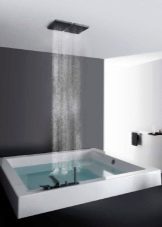
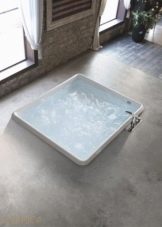
Features and materials
The square-shaped bathtub immediately reveals the creative idea of the decorators. This solution allows you to emphasize originality and adherence to the latest fashion trends. Such structures can be made from different materials:
- acrylic;
- become;
- cast iron.
Cast iron modifications are distinguished by high mechanical strength and are used for a long time. But their heaviness complicates both installation and subsequent maintenance, elimination of accidents on communications. Steel turns out to be somewhat lighter, but when the water jet touches the surface, there is a lot of noise.
Therefore, acrylic square bathtubs are the best choice in terms of practicality.



However, acrylic can fall into different categories. Often there is a "composite plastic", abbreviated as "PMMA + ABS". The bottom line is that the bathtub has two layers. Acrylic is used only outside, and underneath is another plastic that is not resistant to water. Obvious weakness - if the outer layer is broken, the core quickly breaks down.
Another popular option is cast acrylic. This material is very mechanically stable and not subject to deformation. As for the extrusion type, it is distinguished by a lower strength of molecular bonds than in the "cast" version. But the purchase costs will be slightly less.
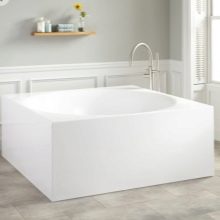


There are a number of reasons why it is appropriate to choose acrylic:
- it conducts heat rather little;
- despite the smoothness, the surface will not slip;
- when water is poured from the tap, there is no noise;
- a bathtub of any size can be easily made at the discretion of designers and customers;
- the material has a pleasant glossy appearance;
- acrylic does not contain pores that could clog.
But this does not mean that acrylic designs are completely devoid of flaws. They do not allow the use of powders or other abrasive cleaning compounds. Strong solvents can also be harmful to synthetics. And even if its strength does not weaken, the gloss of the surface will be largely lost.
In addition, the smooth outer layer is prone to scratches and other imperfections.



An acrylic bathtub can also deform when exposed to heavy objects. And sometimes not too heavy, but with metal parts of the surface. It will also be inappropriate to soak colored garments in an acrylic bathtub or pour the water left after hand washing into it. This will almost inevitably lead to surface contamination with the appropriate colorants.
Important: when choosing a specific acrylic bathtub, you need to make sure that it consists of a sufficient number of layers, and that there are no unpleasant odors.
You can also mention such exotic options for square designs, such as made from:
- concrete;
- wood;
- natural stone.
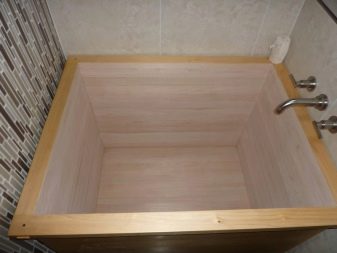

Dimensions (edit)
Of course, a bathtub measuring 80x80 or 90x90 cm is only useful for bathing the smallest children. For older children, sizes 100x100 and 120x120 are suitable. In adolescence, models 130x130 and 140x140 cm are suitable.The latter option, as well as 150x150 cm and more, will be useful for most adults.
It is also necessary to pay attention to the depth of the structure. When it is more than 0.5-0.6 m, there is a high risk of accidental head-diving. The width of a bathing accessory is determined by its own shoulder width.
It is important to distinguish between the dimensions of the bath body itself and its bowl. The inner container in a square product can have any shape, limited only by the imagination of customers.
The feet are used to maintain the desired distance between the floor and the drain.

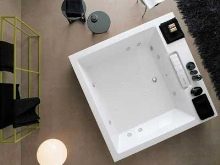

Views
The square bathtub can be built-in or side-mounted. Embedding considered an attractive option, however, it is used mainly in private homes. Mortise plumbing models are placed either in a recess in the floor, or on a pedestal equal to the height of the bathing container itself. Obviously, in an apartment building, it is extremely rare to do both without interfering with the supporting structures. And it's not only technical problems, but also the need to obtain official permission, which may not be given.
Side baths are used much more often. In addition to ease of installation, they also attract attention by saving useful space. The use of both legs and ready-made bases is allowed. In the second case, it will be easier to put the "font" in the place allotted for it. If space is available, free-standing square bathtubs can also be used.



Returning briefly to the materials, it is worth noting that acrylic is divided into industrial and sanitary types. The second option is preferable because it contains a number of additives that reduce the risk of microorganisms. This material is used by any self-respecting manufacturer of bathtubs.
The thickness of the acrylic used is also important. If it is 0.5-0.6 cm, then a very long service is guaranteed, even in difficult conditions.
However, forming such thick sheets is difficult even with the use of the most modern equipment.



Additional elements
To improve user comfort, the following are used:
- headrests;
- curtains;
- built-in backlight;
- a number of other accessories.
Both soft materials (nylon or polyethylene) and hard materials (PVC, other plastics, glass) can be used to create curtains.The role of the curtain is not limited to improving the appearance - thanks to them, the flooring and the rest of the room are protected from splashing water.



How to choose?
Designer models with an original look are often made of relatively thin extruded acrylic. It is sometimes used in conjunction with ABS plastics. This innovation has little effect on practical qualities, but it allows us to guarantee an optimal price. But products made of extrusion and combined acrylic can last a maximum of 3-5 years, then they will need to be changed.
In appearance, even an experienced specialist will not determine where is "casting" and where is "extrusion".



Therefore, it is very important to require hygiene certificates for the purchased product.... If the seller is not ready to provide them immediately, it is better to completely refrain from buying from him. It is advisable to look at the skylight - high-quality bathtubs do not allow visible light to pass through completely. If this check is successful, you need to test the bottom. With the permission of the seller, they get up inward and tread on one place, or they simply press firmly with their hand.
The bottom should not bend. If this happens, there is no doubt - soon the bath will be covered with a network of cracks.... The bottom should have clearly visible roughness from the inside. They allow you to exclude slipping of body parts even in water with a lot of soap.



You also need to look at the sides of the bathtubs. If in the light of the flashlight irregularities are noticeable, even the smallest, we can confidently say that acrylic is extremely thin. By touching the side walls in the middle, you can find out if they bend or not. Of course the deflection indicates a gross violation of technological standards.
Only two layers should be visible on the cut of the bath. If there are more of them, then the use of plastic reinforcement is evident, which is intended to hide the low quality of the product as a whole.



It makes almost no sense to purchase acrylic bathtubs from Russian and Chinese manufacturers.. They use mostly low quality material. Such acrylic will only last until the first serious scratch, and then it will have to be thrown away due to its complete unsuitability for repair. Of course, in the case of cast iron, steel or wood, Russian and Chinese goods are no worse than those supplied from Europe and the United States.



For tips on choosing a bath, see the following video.








